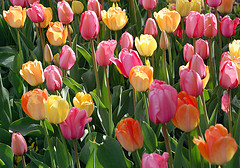Spring is turning to summer here in the Northern Hemisphere, and the world is in blossom. Flowers always make me think of Chairman Mao, who once vowed to “let a hundred flowers bloom” in China, meaning that the nation would be healthier if a diversity of ideas could compete for attention. But in real life, sometimes the wrong flowers win the war of ideas, leading us up a primrose path of misconceptions and misinformation. This month, Jeopardy! champ Ken Jennings digs up all kinds of floral falsehoods from the fertile soil of his mind, separating the weeds of legend from the pick-me-up bouquet… of truth.
Flower Myth #1: Tulips Are Native to the Netherlands.
I’ll grant you that windmills, wooden shoes, and heroin are pretty great, but, as signifiers of the Netherlands go, there’s everything else and then there’s the mighty tulip. What could be more Dutch than a field of brightly colored tulips, swaying in the wind? The Netherlands still produces three billion tulips every year, and its Keukenhof garden, near Lisse, is the largest tulip display in the world. But would it surprise you to know that tulips aren’t Dutch at all—that the de facto national flower is, in fact, a fairly recent immigrant?

Tulips are actually native to the steppes of the Near East and central Asia, and were probably first cultivated by the Turks—our word “tulip” comes from the Ottoman word tulbend, from the Persian for “turban.” In the most popular account, a German ambassador to the Turkish court brought tulip bulbs back to Bavaria in the sixteenth century, and in 1594, the Flemish botanist Carolus Clusius spread the love to Holland, planting bulbs from Vienna in the university botanical garden at Leiden.
At the time, the tulip was the only flower grown in Europe that could boast such intense and varied color, and displaying its blossoms quickly became an important Dutch status symbol. Eventually this led to “tulip mania,” one of the first speculative bubbles in history. A nineteenth-century account of the boom by a British journalist notes that, at one point, tulip values got so overinflated that twelve acres of land were trading for just one bulb. In 1637, the bubble finally popped, taking much of the Dutch economy with it, but by that time, the flower’s place in the culture and history of the Netherlands was assured. The tulip had gone Dutch.
Quick Quiz: What tulip-loving musician was born Herbert Khaury in New York City on April 12, 1932?
Ken Jennings is the author of Brainiac, Ken Jennings's Trivia Almanac, and Maphead. He's also the proud owner of an underwhelming Bag o' Crap. Follow him at ken-jennings.com or on Twitter as @KenJennings.
Photo by Flickr member The Glass Beehive*. Used under a Creative Commons License.


